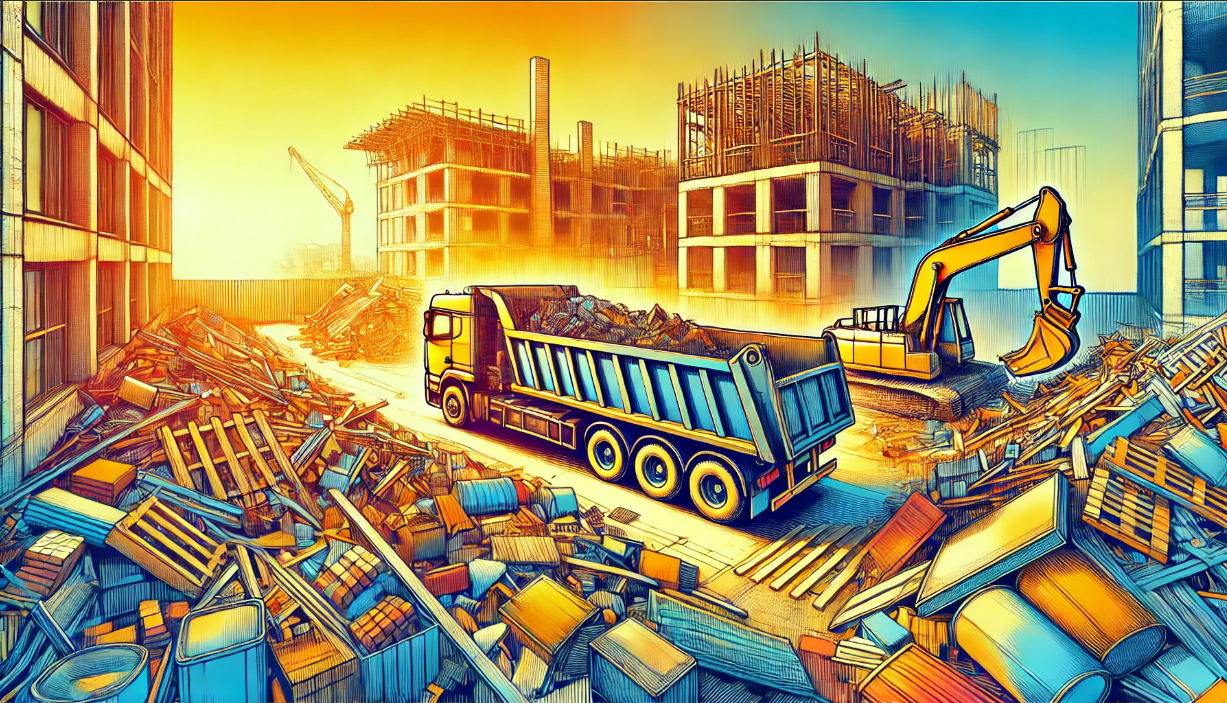Proudly Serving Orange & Long Beach Counties

How to Effectively Handle Construction Debris Removal
Construction projects often generate massive amounts of debris, from scrap materials to hazardous waste. Whether you're managing a small home renovation or a large-scale building project, efficient debris removal is critical for keeping the site clean, safe, and compliant with local regulations. In this guide, we’ll walk you through the steps of construction debris removal and offer practical tips for effective waste management.
What is Construction Debris?
Construction debris refers to the waste generated during construction, renovation, or demolition activities. This includes materials such as concrete, wood, metals, bricks, drywall, and sometimes even hazardous materials like asbestos and lead. If not managed properly, construction waste can pose safety hazards and harm the environment.
Why is Proper Debris Removal Important?
Improper handling of construction debris can result in numerous issues, such as:
- Safety hazards: Loose materials can cause accidents and injuries on-site.
- Environmental damage: Toxic substances can leak into the soil and water sources.
- Legal consequences: Failure to comply with waste disposal regulations can lead to fines and project delays.
Ensuring proper debris removal improves safety, boosts efficiency, and helps you avoid potential legal problems.
Steps to Efficiently Handle Construction Debris Removal
Assess the Type of Debris
- Identify the types of materials you're dealing with. Is it mostly wood, metal, or concrete? Or does it include hazardous waste like asbestos?
- Segregate the debris to determine which materials can be recycled or reused and which need to be disposed of in specific ways.
Create a Debris Management Plan
- Set up designated areas on your construction site for different types of waste.
- Use clearly marked bins for recyclable and non-recyclable materials to avoid confusion.
Hire a Professional Junk Removal Service
- Partnering with a professional debris removal company ensures that waste is handled responsibly and in compliance with local regulations.
- Benefits of hiring professionals include proper equipment, experience with hazardous materials, and disposal permits.
Safety Precautions
- Always use proper personal protective equipment (PPE), including gloves, hard hats, and masks.
- Ensure hazardous materials are handled by trained professionals to avoid exposure to harmful substances.
Schedule Regular Debris Pickups
- Don’t wait until the end of your project to remove debris. Scheduling regular pickups keeps the worksite clean and prevents debris from accumulating.
Recycle and Reuse
- Recycling materials such as concrete, metal, and wood is a sustainable way to handle debris.
- If possible, reuse materials like bricks or tiles in other parts of the project, reducing costs and environmental impact.
Construction Debris Removal: Tools and Equipment
Managing construction debris removal often requires specific tools. Below is a list of equipment commonly used in debris management:
| Tool/Equipment | Purpose |
|---|---|
| Dumpsters | Large containers for collecting and disposing waste |
| Skid-steer loaders | Moving large piles of debris |
| Protective gear | Ensuring worker safety during cleanup |
| Recycling bins | Segregating recyclable materials |
Common Types of Construction Debris and How to Dispose of Them
- Concrete: Can be crushed and reused in future construction projects or disposed of at a landfill.
- Wood: Recyclable or can be repurposed for other construction or DIY projects.
- Metal: Often recycled due to its high value. Scrap metal yards will accept materials like steel and copper.
- Drywall: Should be disposed of according to local regulations, as it can contain hazardous materials.
- Hazardous Waste (e.g., asbestos, lead-based paints): Must be handled and disposed of by certified professionals due to the risks associated with exposure.
Tips for Eco-Friendly Construction Debris Removal
- Minimize Waste: Plan your material purchases carefully to avoid over-ordering and generating excess waste.
- Choose Recyclable Materials: Whenever possible, use materials that can be easily recycled.
- Donate Usable Materials: Leftover materials like bricks, tiles, or wood can be donated to charities or reused for other projects.
Frequently Asked Questions (FAQs)
1. What types of debris can be recycled?
Many construction materials like wood, metal, concrete, and bricks can be recycled. Consult with local recycling centers to confirm which items they accept.
2. Can I handle hazardous waste myself?
No, handling hazardous materials like asbestos or lead requires specialized training. It's best to
hire professionals for proper disposal.
3. How often should debris be removed from a construction site?
Debris should be removed regularly, ideally daily or weekly, depending on the size of the project. Keeping a clean site helps prevent accidents and increases productivity.
4. How much does it cost to remove construction debris?
Costs vary depending on the amount and type of debris, the location of the project, and the distance to disposal sites. Hiring a junk removal service typically ranges from $200 to $1,500 depending on these factors.
Managing construction debris is crucial for maintaining a safe and efficient worksite. By following proper safety guidelines, hiring professionals, and recycling materials, you can ensure that your project remains environmentally responsible and compliant with local laws.
Engage with us! Do you have any additional tips for handling construction debris? Share your thoughts in the comments below or tag us on social media! If you're in need of professional construction debris removal services,
contact us today for a free consultation! Our team is ready to keep your construction site safe and clean.
Contact us
If you have any questions or need any assistance after business hours, please get in touch.
Phone
BUSINESS HOURS
- Mon - Sun
- -

We will get back to you as soon as possible.
Please try again later.
All Rights Reserved | Planet Haulers Junk Removal
